Abstract
Previous studies have shown that log IgD levels in normal individuals are distributed in a nonunimodal manner. Therefore, in this study we tested whether inheritance might play a role in determination of IgD levels. IgD levels were measured in serum or plasma from 301 randomly selected children aged 6-18 yr, 245 consecutive adult blood donors, and 134 first-degree relatives of subjects with low IgD levels. Comparison of serum and plasma from five individuals revealed no difference, so the two were used interchangeably. The distributions of log IgD levels in randomly selected populations of both adults and children were nonunimodal with nadirs at 2.15 IU/ml. In both of these randomly selected populations, 13-14% of the subjects had low IgD values (<2.15 IU/ml). In addition, there was a significant sibling-sibling correlation of log IgD values (r = 0.56, n = 72, P <0.01). Because of the nonunimodality of the frequency distribution histogram for IgD values and because of the familial aggregation of these values, the study was extended to include first-degree relatives of subjects with low plasma IgD. Blood samples from 92% of living first-degree relatives, 134 individuals, were analyzed for their level of IgD, and the results of segregation and pedigree analyses of these data were compatible with autosomal recessive inheritance of an allele for low plasma IgD levels. IgD values in plasma from siblings of probands for low IgD were also non-unimodal in distribution with a nadir at ≅2.15 IU/ml. The results suggest that there is autosomal recessive inheritance of an allele for low plasma IgD.
Full text
PDF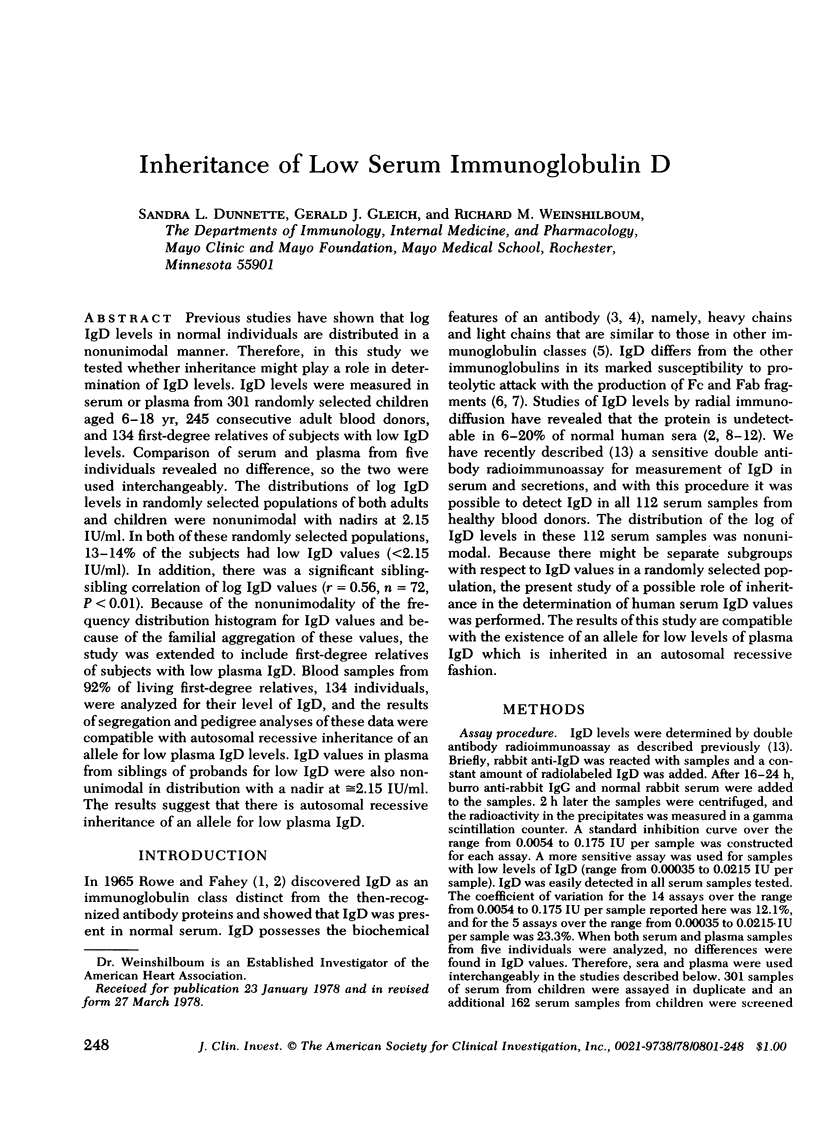
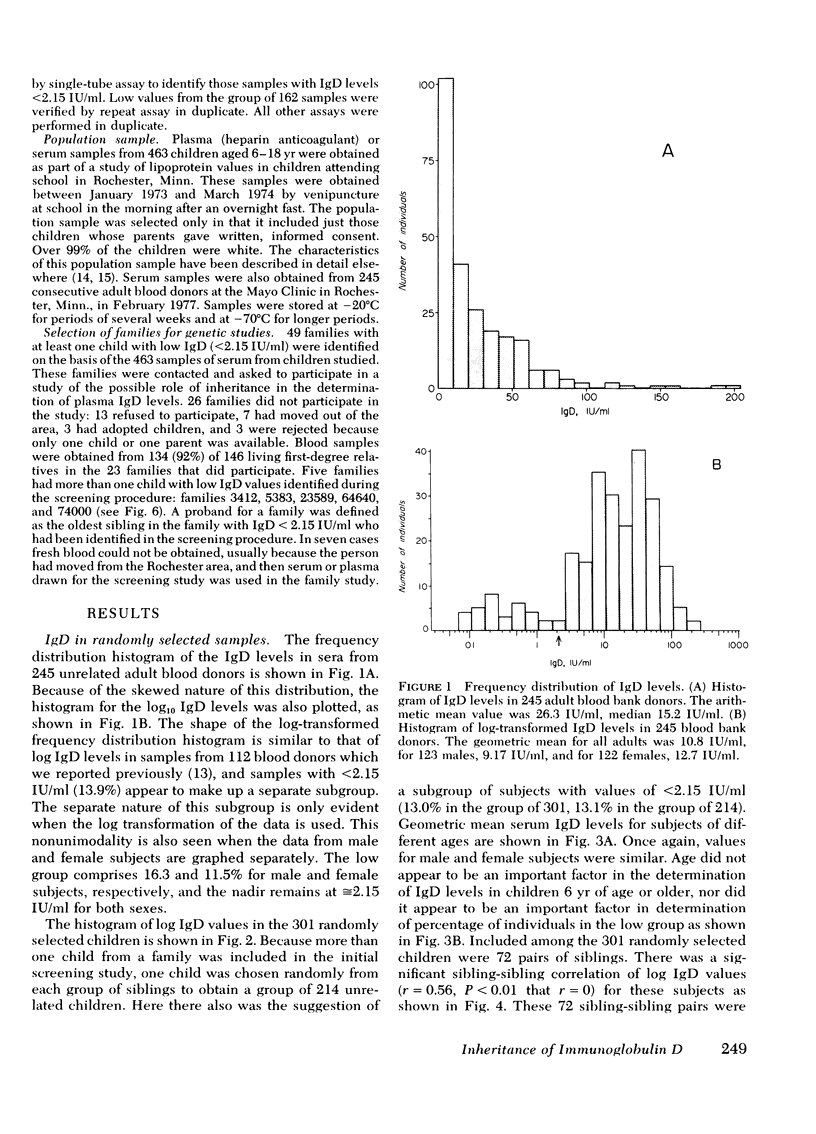
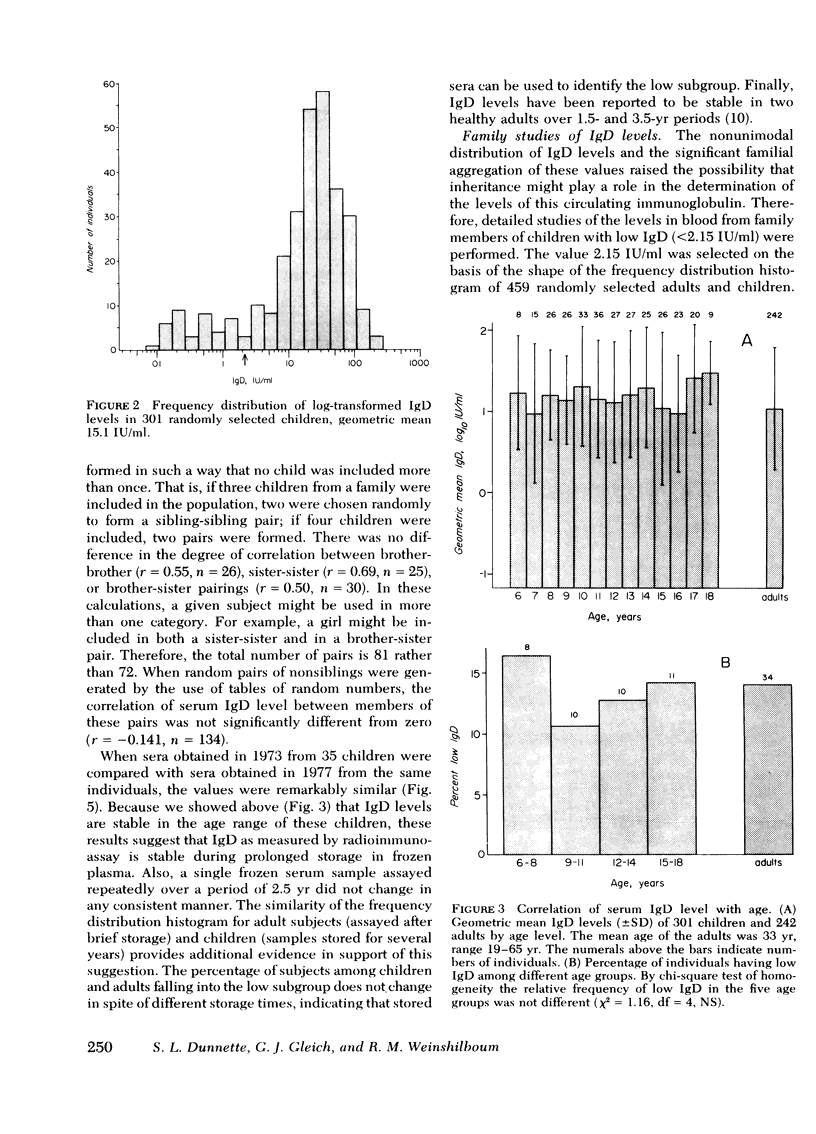
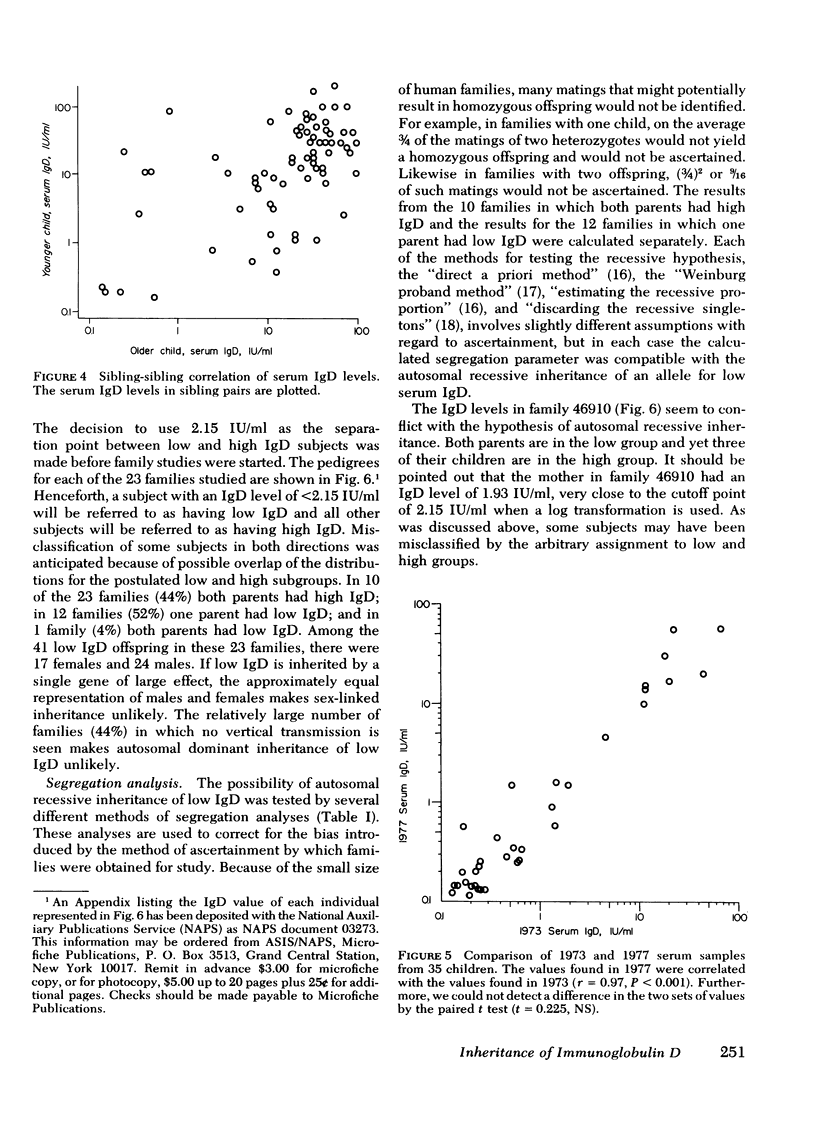
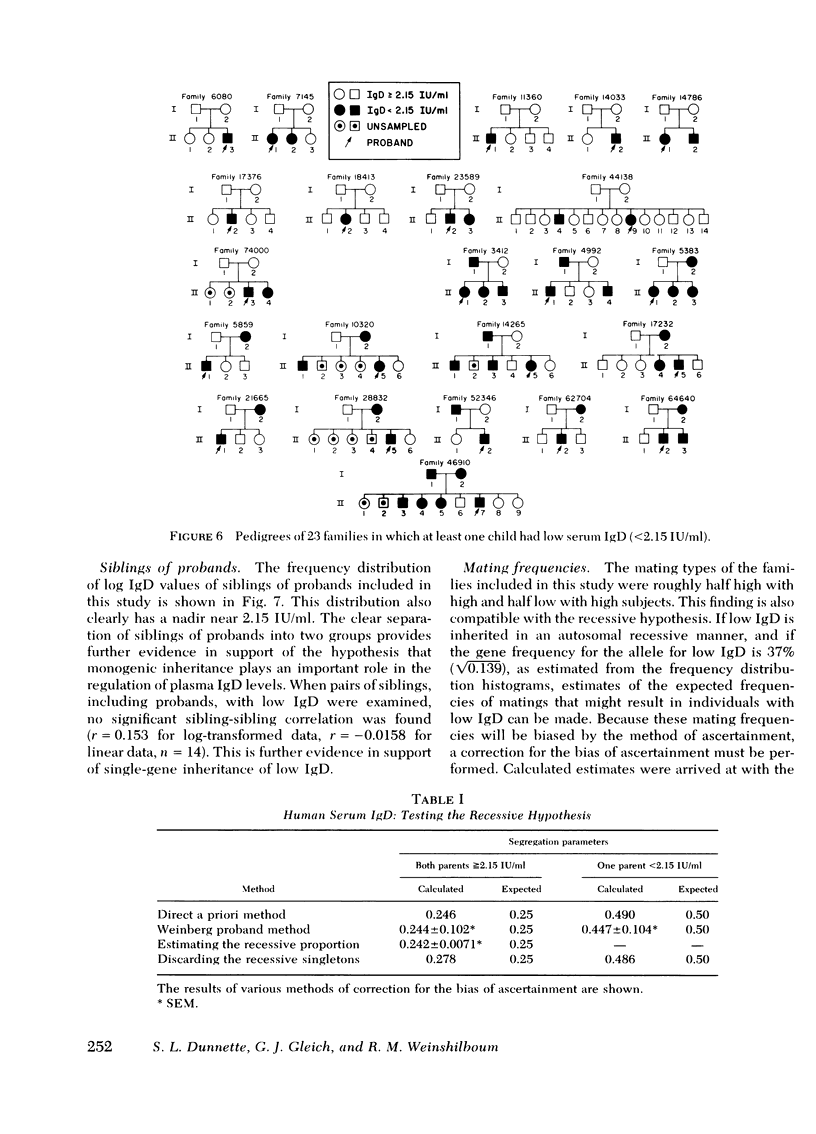
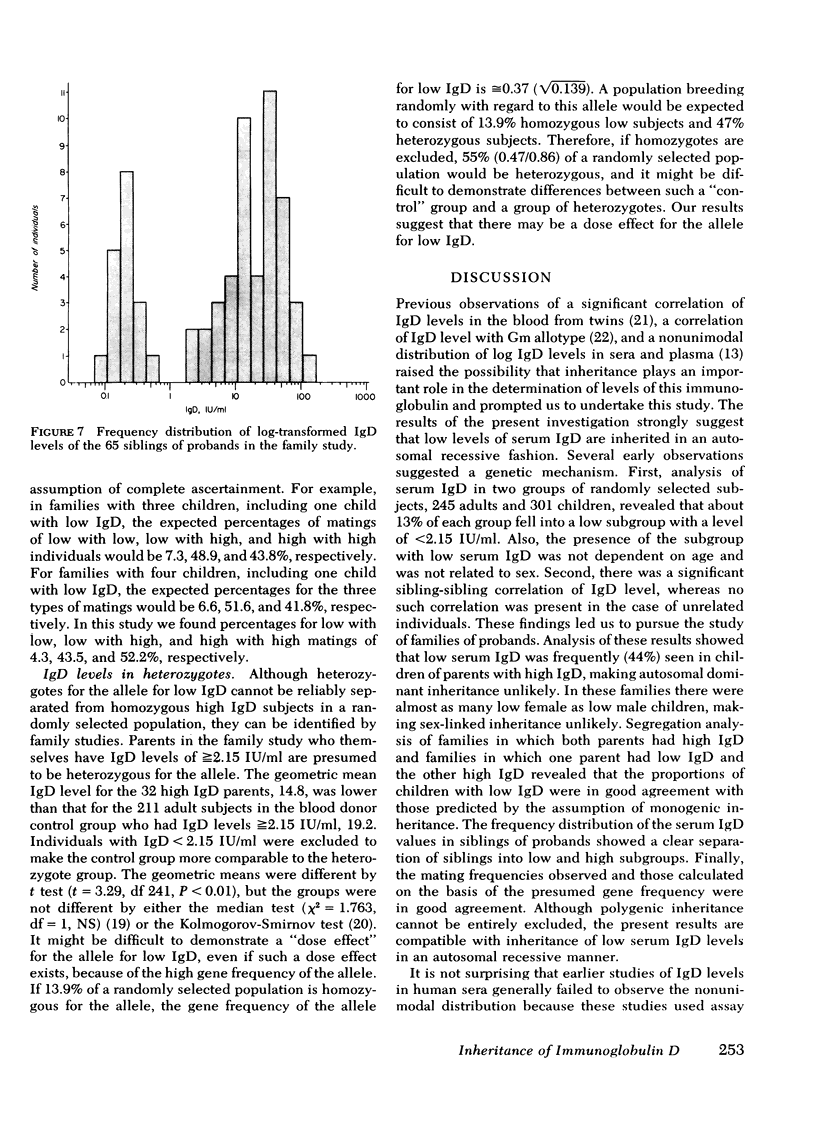
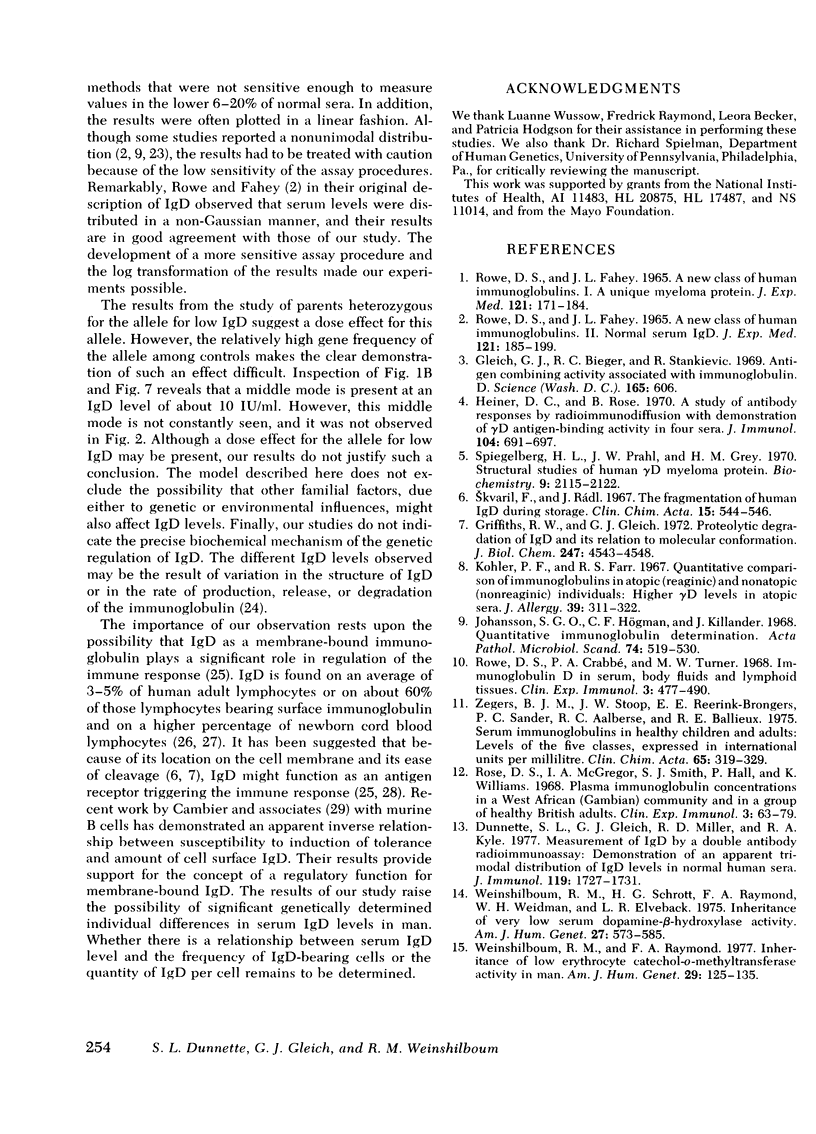
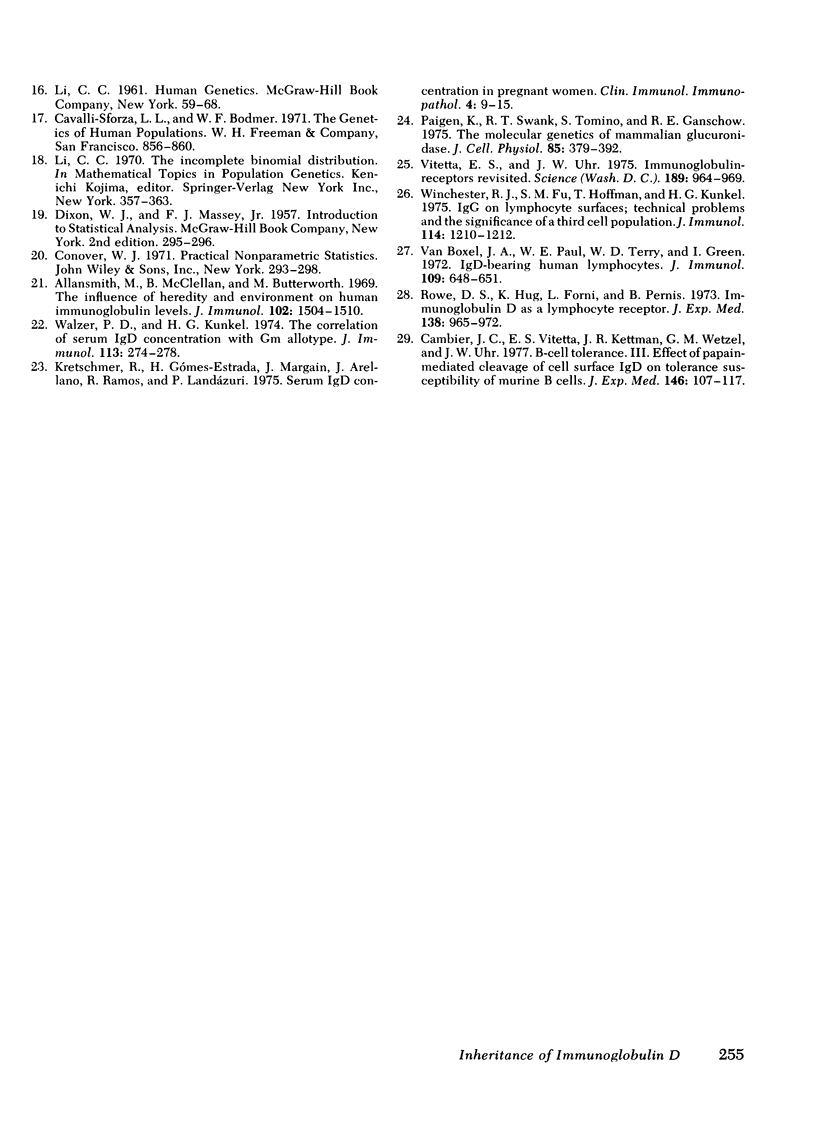
Selected References
These references are in PubMed. This may not be the complete list of references from this article.
- Allansmith M., McClellan B., Butterworth M. The influence of heredity and environment on human immunoglobulin levels. J Immunol. 1969 Jun;102(6):1504–1510. [PubMed] [Google Scholar]
- Cambier J. C., Vitetta E. S., Kettman J. R., Wetzel G. M., Uhr J. W. B-cell tolerance. III. Effect of papain-mediated cleavage of cell surface IgD on tolerance susceptibility of murine B cells. J Exp Med. 1977 Jul 1;146(1):107–117. doi: 10.1084/jem.146.1.107. [DOI] [PMC free article] [PubMed] [Google Scholar]
- Dunnette S. L., Gleich G. J., Miller R. D., Kyle R. A. Measurement of IgD by a double antibody radioimmunoassay: demonstration of an apparent trimodal distribution of IgD levels in normal human sera. J Immunol. 1977 Nov;119(5):1727–1731. [PubMed] [Google Scholar]
- Gleich G. J., Bieger R. C., Stankievic R. Antigen combining activity associated with immunoglobulin D. Science. 1969 Aug 8;165(3893):606–606. doi: 10.1126/science.165.3893.606. [DOI] [PubMed] [Google Scholar]
- Griffiths R. W., Gleich G. J. Proteolytic degradation of IgD and its relation to molecular conformation. J Biol Chem. 1972 Jul 25;247(14):4543–4548. [PubMed] [Google Scholar]
- Heiner D. C., Rose B. A study of antibody responses by radioimmunodiffusion with demonstration of gamma D antigen-binding activity in four sera. J Immunol. 1970 Mar;104(3):691–697. [PubMed] [Google Scholar]
- Johansson S. G., Högman C. F., Killander J. Quantitative immunoglobulin determination. Comparison of two methods. Estimation of normal levels and levels in persons lacking IgA and IgD. Acta Pathol Microbiol Scand. 1968;74(4):519–530. [PubMed] [Google Scholar]
- Kohler P. F., Farr R. S. Quantitative comparison of immunoglobulins in atopic (reaginic) and nonatopic (nonreaginic) individuals: higher gamma-D levels in atopic sera. J Allergy. 1967 May;39(5):311–322. doi: 10.1016/0021-8707(67)90095-0. [DOI] [PubMed] [Google Scholar]
- Kretschmer R. R., Gómez-Estrada H., Margain J. C., Arellano J., Ramos R., Landázuri P. Serum IgD concentration in pregnant women. Clin Immunol Immunopathol. 1975 May;4(1):9–15. doi: 10.1016/0090-1229(75)90033-1. [DOI] [PubMed] [Google Scholar]
- Paigen K., Swank R. T., Tomino S., Ganschow R. E. The molecular genetics of mammalian glucuronidase. J Cell Physiol. 1975 Apr;85(2 Pt 2 Suppl 1):379–392. doi: 10.1002/jcp.1040850406. [DOI] [PubMed] [Google Scholar]
- ROWE D. S., FAHEY J. L. A NEW CLASS OF HUMAN IMMUNOGLOBULINS. I. A UNIQUE MYELOMA PROTEIN. J Exp Med. 1965 Jan 1;121:171–184. doi: 10.1084/jem.121.1.171. [DOI] [PMC free article] [PubMed] [Google Scholar]
- ROWE D. S., FAHEY J. L. A NEW CLASS OF HUMAN IMMUNOGLOBULINS. II. NORMAL SERUM IGD. J Exp Med. 1965 Jan 1;121:185–199. doi: 10.1084/jem.121.1.185. [DOI] [PMC free article] [PubMed] [Google Scholar]
- Rowe D. S., Crabbé P. A., Turner M. W. Immunoglobulin D in serum, body fluids and lymphoid tissues. Clin Exp Immunol. 1968 Jul;3(6):477–490. [PMC free article] [PubMed] [Google Scholar]
- Rowe D. S., Hug K., Forni L., Pernis B. Immunoglobulin D as a lymphocyte receptor. J Exp Med. 1973 Oct 1;138(4):965–972. doi: 10.1084/jem.138.4.965. [DOI] [PMC free article] [PubMed] [Google Scholar]
- Rowe D. S., McGregor I. A., Smith S. J., Hall P., Williams K. Plasma immunoglobulin concentrations in a West African (Gambian) community and in a group of healthy British adults. Clin Exp Immunol. 1968 Jan;3(1):63–79. [PMC free article] [PubMed] [Google Scholar]
- Skvaril F., Rádl J. The fragmentation of human IgD during storage. Clin Chim Acta. 1967 Mar;15(3):544–546. doi: 10.1016/0009-8981(67)90023-x. [DOI] [PubMed] [Google Scholar]
- Spiegelberg H. L., Prahl J. W., Grey H. M. Structural studies of human gamma D myeloma protein. Biochemistry. 1970 May 12;9(10):2115–2122. doi: 10.1021/bi00812a013. [DOI] [PubMed] [Google Scholar]
- Van Boxel J. A., Paul W. E., Terry W. D., Green I. Communications. IgD-bearing human lymphocytes. J Immunol. 1972 Sep;109(3):648–651. [PubMed] [Google Scholar]
- Vitetta E. S., Uhr J. W. Immunoglobulin-receptors revisited. Science. 1975 Sep 19;189(4207):964–969. doi: 10.1126/science.1083069. [DOI] [PubMed] [Google Scholar]
- Walzer P. D., Kunkel H. G. The correlation of serum IgD concentration with Gm allotype. J Immunol. 1974 Jul;113(1):274–278. [PubMed] [Google Scholar]
- Weinshilboum R. M., Raymond F. A. Inheritance of low erythrocyte catechol-o-methyltransferase activity in man. Am J Hum Genet. 1977 Mar;29(2):125–135. [PMC free article] [PubMed] [Google Scholar]
- Weinshilboum R. M., Schorott H. G., Raymond F. A., Weidman W. H., Elveback L. R. Inheritance of very low serum dopamine-beta-hydroxylase activity. Am J Hum Genet. 1975 Sep;27(5):573–585. [PMC free article] [PubMed] [Google Scholar]
- Winchester R. J., Fu S. M., Hoffman T., Kunkel H. G. IgG on lymphocyte surfaces; technical problems and the significance of a third cell population. J Immunol. 1975 Apr;114(4):1210–1212. [PubMed] [Google Scholar]
- Zegers B. J., Stoop J. W., Reerink-Brongers E. E., Sander P. C., Aalberse R. C., Ballieux R. E. Serum immunoglobulins in healthy children and adults. Levels of the five classes, expressed in international units per millilitre. Clin Chim Acta. 1975 Dec 15;65(3):319–329. doi: 10.1016/0009-8981(75)90257-0. [DOI] [PubMed] [Google Scholar]


